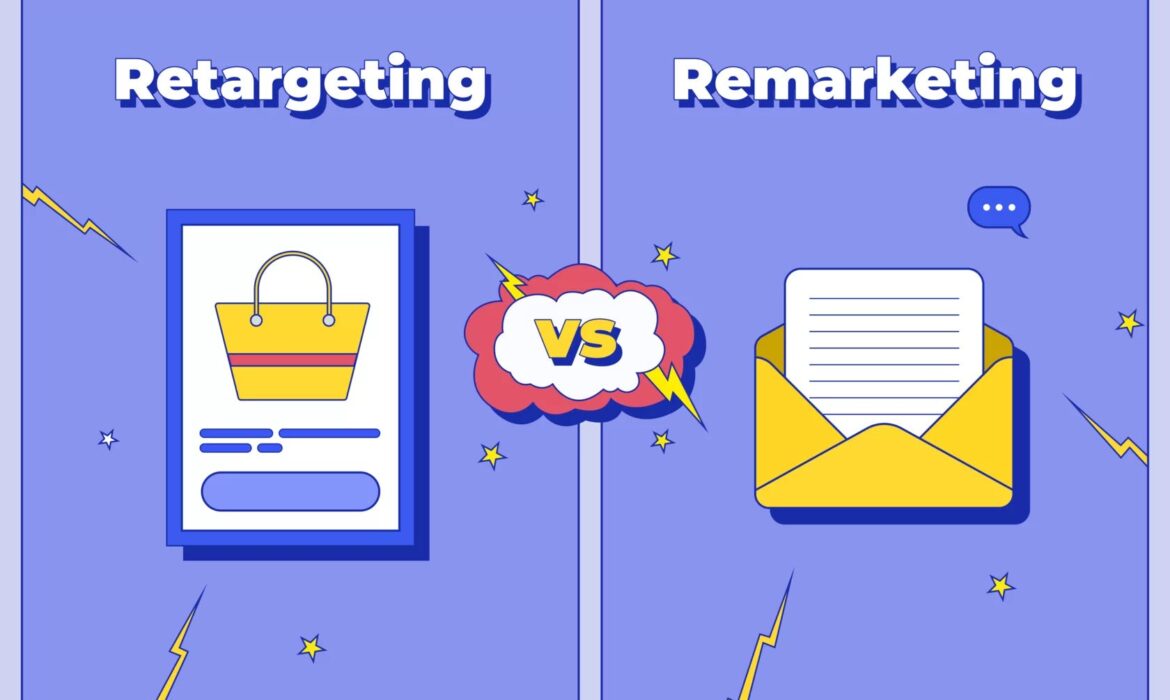Remarketing vs. Retargeting: Understanding the Difference and Why It Matters – 2025

In today’s dynamic digital landscape, businesses are continuously refining their strategies to engage customers and drive conversions. Two key tactics that often generate confusion are remarketing and retargeting. While these terms are sometimes used interchangeably, they represent distinct approaches to re-engaging potential customers. In this comprehensive guide, we’ll explore the differences between remarketing and retargeting, discuss their importance in 2025, address common pain points and challenges, and provide actionable solutions to help you harness their full potential. We’ll also answer frequently asked questions to ensure you have a clear understanding of these concepts. Whether you’re a digital marketing professional or a business owner, this guide is designed to help you optimize your campaigns for maximum impact.
Table of Contents
- Introduction
- Defining Remarketing
- Defining Retargeting
- Key Differences Between Remarketing and Retargeting
- Why the Distinction Matters in 2025
- Common Pain Points and Challenges
- Solutions and Best Practices
- Tools and Technologies
- Future Trends in Customer Re-engagement
- Frequently Asked Questions (FAQ)
- Conclusion
- Contact Us
Introduction
In the realm of digital advertising, the ability to re-engage customers who have shown interest but did not convert is crucial. Both remarketing and retargeting serve this purpose, yet they function differently within your digital marketing ecosystem. With rapid advancements in AI-driven search models—such as Google Gemini, ChatGPT, DeepSeek, and Perplexity—coupled with evolving consumer behavior, it is more important than ever to understand these tactics and implement them effectively.
This article delves into the core concepts behind remarketing and retargeting, illustrating their unique characteristics and strategic benefits. We also address key challenges marketers face, including budget constraints, audience segmentation issues, and the integration of these tactics into an overarching digital marketing strategy. With a focus on actionable insights and real-world applications, our aim is to equip you with the knowledge needed to rank #1 on Google and achieve robust campaign performance.
Defining Remarketing
Remarketing is a strategy that involves reconnecting with customers who have previously interacted with your brand—whether by visiting your website, subscribing to a newsletter, or engaging with your content. The primary objective is to remind them of your brand’s value proposition and encourage them to return to complete a purchase or take another desired action.
Key Characteristics of Remarketing:
- Email Campaigns: Often involves sending follow-up emails to previous visitors, providing tailored offers or content.
- Customized Messaging: Content is personalized based on past interactions, ensuring relevance.
- Multi-Channel Approach: Can span across various channels, including social media, display ads, and SMS, to create a cohesive experience.
- Data-Driven: Utilizes customer data (such as browsing behavior, purchase history, and demographics) to segment audiences and craft targeted campaigns.
Remarketing is particularly effective in nurturing leads that are still in the consideration stage. By staying top-of-mind, your brand can slowly guide potential customers along the conversion funnel.
LSI Keywords: customer re-engagement, lead nurturing, personalized email campaigns, targeted messaging
Defining Retargeting
Retargeting is a subset of remarketing that focuses primarily on serving ads to visitors who have interacted with your website or mobile app but left without converting. The goal is to bring these visitors back by displaying ads as they browse other sites or social media platforms.
Key Characteristics of Retargeting:
- Display Advertising: Involves showing banner ads or video ads to previous visitors.
- Behavioral Segmentation: Uses cookies and tracking pixels to identify and re-engage users.
- Real-Time Engagement: Ads are typically served in real time as the user navigates the internet.
- Visual Appeal: Emphasizes creative visuals and strong calls-to-action (CTAs) to capture attention and drive conversions.
Retargeting is particularly useful for closing the gap with users who have demonstrated a clear interest in your products or services but need an extra nudge to convert. It capitalizes on the familiarity of your brand to increase the likelihood of a purchase.
LSI Keywords: display ads, tracking pixels, behavioral targeting, real-time ad serving, conversion optimization
Key Differences Between Remarketing and Retargeting
While both strategies aim to re-engage potential customers, understanding their differences is crucial for crafting an effective digital marketing plan.
1. Method of Engagement:
- Remarketing:
- Typically involves direct communication methods such as email campaigns, SMS, or personalized website content.
- Focuses on using customer data to create customized follow-up messages.
- Retargeting:
- Primarily revolves around ad placements across various digital channels.
- Uses cookies and tracking pixels to display ads as users navigate different websites.
2. Channel Focus:
Remarketing:
- Often multi-channel, integrating various forms of direct marketing.
- Works well with owned media channels (e.g., email lists, CRM systems).
Retargeting:
- Primarily associated with paid media channels.
- Utilizes third-party networks such as Google Display Network or social media ad platforms.
3. Campaign Objectives:
- Remarketing:
- Aims to build long-term relationships and brand loyalty.
- Focuses on delivering valuable content and personalized offers over time.
- Retargeting:
- Designed to drive immediate conversions by capturing users’ attention through timely ad placements.
- Often used in campaigns with short sales cycles or for products that benefit from quick re-engagement.
4. Measurement and Analytics:
- Remarketing:
- Metrics often include email open rates, click-through rates, and conversion rates from direct messaging campaigns.
- Retargeting:
- Success is typically measured by ad impressions, click-through rates, and the direct conversion rates from ad engagements.
LSI Keywords: customer segmentation, personalized marketing, conversion funnel, ad impressions, campaign metrics
Why the Distinction Matters in 2025
As digital marketing evolves, so do the tools and techniques available to marketers. In 2025, understanding the nuanced differences between remarketing and retargeting is more critical than ever. Here’s why:
Enhanced Personalization and AI Integration
With advancements in artificial intelligence and machine learning, platforms like Google Gemini, ChatGPT, DeepSeek, and Perplexity are revolutionizing how customer data is analyzed. These systems can now offer deeper insights into consumer behavior, enabling hyper-personalized campaigns that blend both remarketing and retargeting strategies. For instance, AI can predict which customers are more likely to respond to a personalized email versus a visual ad, thereby optimizing your budget allocation and messaging.
Improved Customer Experience
Today’s consumers expect seamless and highly relevant interactions with brands. By distinguishing between remarketing and retargeting, businesses can tailor their approaches to meet customer expectations more effectively. A well-executed remarketing campaign can enhance customer loyalty, while a strategic retargeting campaign can drive quick conversions without overwhelming the user with repetitive ads.
Budget Efficiency and ROI
For businesses with limited marketing budgets, understanding these distinctions allows for smarter allocation of resources. Investing in personalized remarketing efforts might yield higher long-term engagement, while a focused retargeting campaign can generate immediate ROI. The ability to strike a balance between the two can lead to more efficient spending and improved overall campaign performance.
Adaptation to Privacy Regulations
With stricter data privacy regulations in place, marketers must be more judicious in how they collect and use customer data. Remarketing strategies that rely on direct customer data (like email lists) may be less affected by these changes, whereas retargeting, which depends heavily on tracking cookies, may face challenges. In 2025, staying compliant while still delivering effective campaigns requires a clear understanding of both tactics and their regulatory implications.
LSI Keywords: AI-driven personalization, customer journey optimization, ROI improvement, budget allocation, privacy compliance
Common Pain Points and Challenges
Despite their potential, many marketers face significant challenges when implementing remarketing and retargeting strategies. Here are some of the key pain points:
1. Data Management and Segmentation
- Challenge:
- Collecting, organizing, and analyzing customer data can be overwhelming, especially for businesses with limited resources.
- Proper segmentation is crucial, yet many marketers struggle to divide their audience effectively.
- Solution:
- Invest in robust CRM and data analytics tools that integrate seamlessly with your marketing platforms.
- Utilize AI and machine learning algorithms to automate segmentation and identify key customer segments for targeted campaigns.
2. Ad Fatigue and Consumer Annoyance
- Challenge:
- Overexposure to retargeting ads can lead to ad fatigue, where users become desensitized or even annoyed by repetitive messaging.
- Solution:
- Develop a frequency cap for retargeting campaigns to limit the number of times a user sees your ad.
- Refresh your creative assets regularly and tailor the messaging to reflect different stages of the customer journey.
3. Integration Across Channels
- Challenge:
- Coordinating remarketing and retargeting efforts across multiple channels can be complex.
- Ensuring a consistent message across email, social media, display ads, and other platforms is vital for maintaining brand coherence.
- Solution:
- Adopt a unified marketing platform that allows for seamless integration of all channels.
- Establish clear guidelines and a content calendar to ensure consistency and coherence across your campaigns.
4. Measurement and Attribution
- Challenge:
- Determining the true impact of remarketing and retargeting efforts on conversions can be difficult, as multiple touchpoints often influence a customer’s decision.
- Solution:
- Implement advanced analytics and attribution models to accurately track the customer journey.
- Use multi-touch attribution systems to understand the contribution of each channel in driving conversions.
5. Ad Budget Optimization
- Challenge:
- Allocating budgets effectively between remarketing and retargeting can be tricky, particularly when resources are limited.
- Solution:
- Analyze historical campaign data to identify which tactics yield the best ROI.
- Consider A/B testing different budget allocations to find the optimal balance for your specific business goals.
LSI Keywords: data segmentation, CRM integration, ad frequency, multi-channel integration, campaign attribution
Solutions and Best Practices
To overcome the challenges outlined above and maximize the effectiveness of your remarketing and retargeting campaigns, consider the following best practices:
1. Adopt a Holistic Marketing Strategy
- Integrate both remarketing and retargeting into your overall marketing strategy.
- Ensure that both tactics work synergistically to nurture leads and drive conversions.
2. Invest in Technology and Automation
- Leverage advanced marketing automation tools to manage data segmentation, campaign scheduling, and performance tracking.
- Utilize AI-driven insights to continuously refine your audience targeting and creative messaging.
3. Develop Compelling, Personalized Content
- Focus on creating high-quality, relevant content that resonates with your segmented audiences.
- Use dynamic content strategies that adapt based on user behavior and preferences, ensuring each interaction feels personalized.
4. Regularly Refresh Creative Assets
- Keep your ad creatives and messaging fresh to avoid ad fatigue.
- Rotate visuals, headlines, and CTAs frequently to maintain user interest and engagement.
5. Implement a Robust Analytics Framework
- Set up a comprehensive analytics dashboard that consolidates data from all channels.
- Use attribution models to gain a clear understanding of how each campaign contributes to overall performance.
- Continuously monitor key metrics such as CTR, conversion rates, and ROI to identify areas for improvement.
6. Test and Iterate
- Use A/B testing to evaluate different strategies and creative elements.
- Continuously experiment with new ideas and adjust your approach based on data-driven insights.
- Keep abreast of emerging trends and incorporate them into your strategy to stay ahead of the competition.
LSI Keywords: marketing automation, dynamic content, analytics dashboard, A/B testing, continuous improvement
Tools and Technologies
To successfully implement and optimize remarketing and retargeting campaigns in 2025, consider using the following tools and technologies:
1. Customer Relationship Management (CRM) Systems
- Examples: Salesforce, HubSpot, Zoho CRM
- Benefits: Manage customer data effectively, automate segmentation, and personalize communications.
2. Ad Platforms and Networks
- Examples: Google Ads, Facebook Ads, LinkedIn Ads
- Benefits: Enable precise targeting through tracking pixels and advanced audience segmentation.
3. Marketing Automation Tools
- Examples: Marketo, ActiveCampaign, Mailchimp
- Benefits: Streamline campaign management, schedule automated email flows, and track performance metrics.
4. Analytics and Attribution Software
- Examples: Google Analytics, Adobe Analytics, Attribution App
- Benefits: Gain insights into user behavior, measure conversion paths, and evaluate campaign performance across multiple touchpoints.
5. Creative Design Tools
- Examples: Canva, Adobe Creative Cloud, Figma
- Benefits: Produce high-quality visuals and dynamic ad creatives that capture user attention and drive engagement.
LSI Keywords: CRM systems, ad networks, marketing automation, attribution models, creative design
Future Trends in Customer Re-engagement
As digital marketing continues to evolve, so will the strategies for remarketing and retargeting. Here are a few trends to watch for in 2025 and beyond:
1. Increased AI Personalization
Advancements in AI and machine learning will enable even more precise personalization. Marketers will be able to predict customer behavior with greater accuracy and deliver hyper-targeted messages that resonate on an individual level.
2. Omni-Channel Integration
A seamless, integrated approach across multiple channels will become the norm. Businesses that successfully unify their remarketing and retargeting strategies across email, social media, and display advertising will see improved performance and higher engagement.
3. Enhanced Privacy and Compliance
With data privacy regulations continuously evolving, businesses will need to adopt more transparent and ethical data practices. Future strategies will prioritize consent-based marketing and the ethical use of customer data.
4. Interactive and Dynamic Ads
Expect a rise in interactive and dynamic ad formats that offer richer user experiences. These formats will not only capture attention but also encourage deeper engagement, driving higher conversion rates.
5. Voice and Visual Search Integration
As voice and visual search technologies improve, remarketing and retargeting strategies will need to adapt. Optimizing content for these search formats will become increasingly important to capture emerging trends in consumer behavior.
LSI Keywords: AI personalization, omni-channel marketing, data privacy, interactive ads, voice search, visual search
Frequently Asked Questions (FAQ)
Q1: What is the main difference between remarketing and retargeting?
A: Remarketing generally involves re-engaging customers through direct communication channels such as email and SMS, while retargeting focuses on serving ads to visitors who have left your website using cookies and tracking pixels.
Q2: How can I effectively segment my audience for these campaigns?
A: Use robust CRM tools and AI-driven analytics to segment your audience based on behavior, demographics, and past interactions. This helps tailor your messaging to meet the specific needs of each segment.
Q3: What are the best channels for remarketing and retargeting in 2025?
A: For remarketing, email and SMS remain effective, while retargeting is best executed through display ad networks like Google Ads and social media platforms such as Facebook and LinkedIn.
Q4: How do I measure the success of my remarketing and retargeting campaigns?
A: Key metrics include click-through rates (CTR), conversion rates, return on ad spend (ROAS), and customer engagement levels. Using advanced attribution models can help you understand the contribution of each channel.
Q5: What common challenges should I expect when implementing these strategies?
A: Challenges include data management and segmentation, ad fatigue, integration across channels, accurate measurement of ROI, and budget allocation. Addressing these through automation, testing, and continuous optimization is crucial.
Q6: How do privacy regulations impact these campaigns?
A: Stricter privacy regulations require transparent data practices and user consent. Remarketing strategies based on owned data (like email lists) may be less affected, whereas retargeting, which relies on cookies, must be managed carefully to remain compliant.
Q7: Can I get expert assistance for my digital marketing campaigns?
A: Absolutely. If you’re looking for tailored digital marketing solutions, feel free to contact Morphiaas for expert guidance and support.
Conclusion
In the ever-evolving world of digital marketing, understanding the nuances between remarketing and retargeting is essential for driving customer engagement and optimizing conversion rates. Remarketing focuses on personalized, direct communication, nurturing long-term customer relationships, while retargeting leverages ad placements to prompt immediate action. Both strategies have their unique strengths and challenges, and when integrated effectively, they can significantly boost your ROI.
By adopting a holistic approach that combines advanced data segmentation, creative personalization, and robust analytics, businesses can overcome common hurdles and build campaigns that resonate with their target audience. As we move further into 2025, staying ahead of trends—such as AI-driven personalization, omni-channel integration, and evolving privacy standards—will be key to maintaining a competitive edge.
Implementing these strategies effectively requires a clear understanding of your audience, careful planning, and continuous optimization. Remember that successful digital marketing is not about choosing between remarketing and retargeting; it’s about leveraging both to create a comprehensive, integrated strategy that meets your business goals.
If you’re ready to elevate your digital marketing game and learn more about how to integrate these strategies into your overall plan, feel free to explore additional resources or contact Morphiaas for expert advice.
Contact Us
Have questions or need personalized assistance in implementing remarketing and retargeting strategies? Reach out to our team for tailored digital marketing services that drive results. We’re here to help you navigate the complexities of modern digital marketing and achieve your business objectives.
Contact Morphiaas Today
By following the insights and best practices outlined in this guide, you can demystify the differences between remarketing and retargeting and harness their full potential. With the right strategy and tools, your business will be well-equipped to thrive in the competitive digital landscape of 2025.



